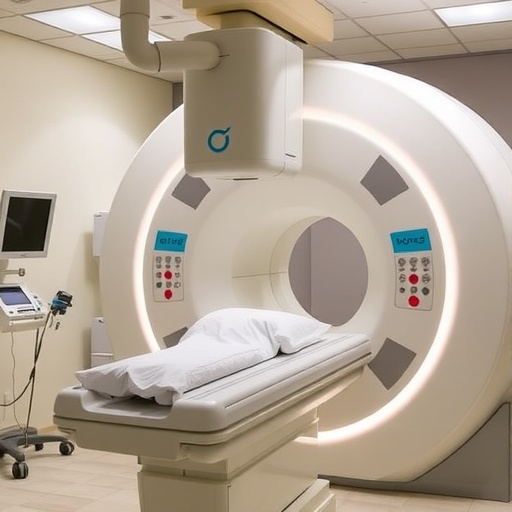In a groundbreaking advancement for cardiac care, radiation therapy has emerged as a promising, noninvasive alternative to repeat catheter ablation for patients suffering from severe refractory ventricular tachycardia (VT). This development, unveiled by researchers at Washington University School of Medicine in St. Louis, challenges the long-held standard of invasive catheter ablation by demonstrating a treatment that is comparable in efficacy but notably safer for patients whose heart arrhythmias can no longer be controlled through medication.
Ventricular tachycardia, a life-threatening condition characterized by dangerously high heart rates originating from abnormal electrical activity in the heart’s ventricles, often leads to significant morbidity and mortality. Traditional management strategies typically include anti-arrhythmic drugs, implantable cardioverter-defibrillators (ICDs), and catheter ablation—where a catheter is threaded through blood vessels into the heart to burn or freeze the problematic tissue. Despite efficacy in early treatments, many patients with refractory or end-stage VT face limited options due to the elevated risks posed by repeated invasive ablations, especially under general anesthesia.
The research team conducted a retrospective analysis of 43 high-risk patients treated between 2015 and 2018, comparing the outcomes of stereotactic arrhythmia radiation therapy (STAR) against those of repeat catheter ablation. STAR is an innovative approach that uses precision-guided beams of ionizing radiation to target and ablate arrhythmogenic cardiac tissue without the need for catheters or anesthesia. This technology not only mitigates procedural risks but also opens possibilities for treating medically fragile patients who might not otherwise tolerate comprehensive invasive procedures.
Findings revealed that patients undergoing cardiac radiation experienced substantially fewer serious adverse events than those who underwent repeat catheter ablation. Within one year post-treatment, 38% of patients in the ablation cohort faced serious complications requiring hospitalization, in stark contrast to just 9% in the radiation group. Notably, complications after ablative procedures manifested rapidly—with a median onset of 6 days—while adverse events related to radiation therapy occurred much later, averaging 10 months post-treatment. This temporal disparity suggests that STAR offers a critical safety advantage by avoiding immediate procedural hazards.
The mortality data underscore the risks associated with invasive ablation. Four patients in the ablation cohort died within one month due to treatment-related complications, including one fatality occurring during the procedure itself. Conversely, the radiation therapy group reported no deaths linked to treatment within a remarkable three-year follow-up period. These results highlight how eliminating anesthesia and catheter insertion can shield already vulnerable patients from the acute harms that frequently accompany repeat cardiac ablations.
While safety profiles clearly favored radiation therapy, both treatments demonstrated similar effectiveness in controlling ventricular arrhythmias. The median time to new persistent VT episodes or ICD shocks was 8.2 months for the radiation group, nearly indistinguishable from the 9.7 months observed for the ablation cohort. This equivalency in arrhythmia control confirms that noninvasive radiation therapy is not merely a safer alternative but also a clinically viable one.
Furthermore, overall survival trends marginally favored the radiation group, with median survival times of 28.2 months compared to 12.2 months for ablation patients. Though not statistically significant due to the study’s modest size, these data suggest that radiation therapy’s lower complication rates contribute to longer patient longevity. By circumventing the early peak of procedural adverse events, STAR may enable patients to maintain cardiac stability for extended periods.
The mechanistic underpinnings of stereotactic arrhythmia radiation therapy capitalize on advances in radiation oncology, employing high-precision imaging techniques and real-time cardiac tracking to deliver highly targeted doses to fibrotic and scarred tissue responsible for arrhythmogenic foci. This precision reduces collateral damage to healthy myocardium and surrounding organs, addressing one of the foremost challenges in applying radiation to cardiac tissues.
Despite the promising evidence, the study’s retrospective nature and limited sample size warrant cautious interpretation. To robustly assess the comparative safety and efficacy of STAR versus catheter ablation, the ongoing RADIATE-VT trial aims to enroll a diverse international cohort in a randomized controlled setting. Results from this pivotal study are eagerly anticipated to validate the initial findings and refine patient selection criteria to optimize therapeutic outcomes.
This evolving paradigm may soon reshape clinical guidelines and expand treatment options for a vulnerable patient population that currently faces few alternatives. As specialized centers worldwide develop the expertise and infrastructure needed to deliver cardiac stereotactic radiation, access to this cutting-edge therapy is expected to grow, offering new hope for patients burdened by refractory ventricular tachycardia.
Moreover, the multidisciplinary collaboration between cardiology and radiation oncology exemplifies how cross-specialty innovation can unlock novel solutions for complex diseases, emphasizing the importance of integrating technologies traditionally associated with oncology into cardiovascular medicine. Such synergy heralds a new era where noninvasive radiation therapies extend their remit beyond cancer to address critical cardiac conditions.
In sum, this pioneering study illuminates a transformative approach in the management of severe cardiac arrhythmias. By demonstrating that stereotactic arrhythmia radiation therapy can deliver effective arrhythmia control with a markedly improved safety profile compared to repeat catheter ablation, it invites a re-evaluation of current therapeutic algorithms and sets the stage for broader adoption of noninvasive cardiologic interventions.
Subject of Research: Comparative outcomes of stereotactic arrhythmia radiation therapy versus repeat catheter ablation for refractory ventricular tachycardia
Article Title: Noninvasive Radiation Therapy Emerges as Safer Alternative to Repeat Catheter Ablation in Refractory Ventricular Tachycardia
News Publication Date: September 29, 2025
Web References:
- American Society for Radiation Oncology (ASTRO) Annual Meeting
- Abstract 247: STAR vs. Repeat Catheter Ablation for High-risk Refractory VT
References:
- Jiang, S. et al., International Journal of Radiation Oncology • Biology • Physics (Red Journal), 2025
- ENCORE-VT Trial Data, Washington University School of Medicine
Keywords:
Cardiac arrhythmias, ventricular tachycardia, stereotactic arrhythmia radiation therapy, catheter ablation, cardiac radiation therapy, noninvasive cardiac treatments, electrophysiology, radiation oncology, refractory ventricular tachycardia, safety outcomes, arrhythmia control, invasive cardiac procedures




